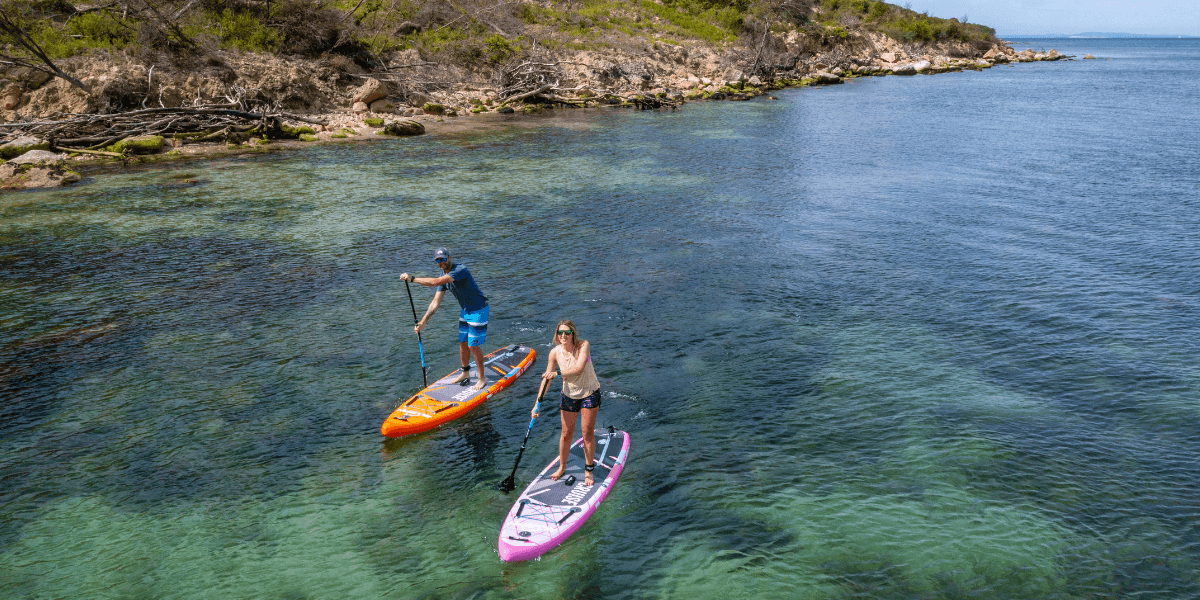We get tons of questions from customers about Paddleboarding, so we thought we would answer some of the most common ones here. You can also check out our board guide for additional information.
How much are Stand Up paddleboards?
The price of your SUP depends on a number of factors, we’ll go over the main points below to help you find the best board for your money.
Size: Bigger boards require more material and are therefore more costly to make.
Quality: A well made paddleboard takes time to research and design. The materials used and construction methods applied also affect the cost. As a rule, unless there is an absolutely wicked sale, you will not find many quality SUPs sold new for less than £400. Cheap paddle boards are not a bargain if they are thin and flimsy and can’t provide enough buoyancy to hold you above the water.
Where you buy: SUP makers who sell in stores will often but not always charge more than those who sell direct to the customer. The added costs of maintaining a storefront can be passed on to the buyer in the price of their board. The exception to this are SUP makers who sell very high volumes in retail stores and are therefor able to extend a better price to their customers. This is not possible for small batch SUPs sold in exclusive boutiques and high end shops.
How do you ride a stand-up paddleboard?
- Make sure your paddle is facing the right way with the the blade angled facing away from you. Hold the paddle with one hand on top and one hand on the middle of the shaft.
- Use your core and not your arms to paddle. This is more effective as it will generate more power. It will also help towards improving your balance and toning those abs.
- Although it may be daunting as a beginner, try to keep your eyes on the horizon, not on the board. This will help you stabilise yourself as the horizon will not move. If it is your first few times on a SUP, ensure you are practising in calm water. Start on your knees, and slowly work your way up to a standing position when you feel comfortable. When you do stand, stay in the middle of the board with your feet about shoulder width apart. Stagger your feet in a fighting stance can help you balance and also prepare you for attacks from giant squid.
- If you do fall in, try to make sure you fall AWAY from your board. Don’t worry, the board will float and if you have a leash the board won’t float away.
- Lastly, tips for how to stand up on a surfboard can help you learn to stand up on a paddleboard as well.
Leo Sear getting the hang of his SUP by kneeling
Source – Leo Sear for Bluefin SUPs
Can you surf on a stand-up paddleboard?
Yes! SUPs are often used by surfers. Many people consider the history of stand up paddleboarding to stem directly from traditional surfing. SUP surfing is a class all its own and has many unique advantages that traditional surfing doesn’t. Some of these include help with balance due to the paddle, help catching waves due to the paddle, and help spotting incoming waves considering you stand on rather than straddle the board.
What does the acronym SUP stand for and how do your pronounce SUP?
The acronym stands for Stand-Up Paddle, Stand-up Paddleboarding or Stand-Up Paddleboard. The history of stand up paddleboarding tells us it may have been around for centuries, even milenia, but the term was not coined ‘til the early 2000s.
In American and British English, “SUP” is pronounced like the word “up” with an “s” on the front.
Can I do stand up paddle boarding for exercise?
Yes! Stand up Paddleboarding is extremely good exercise, even if you paddle leisurely. Not only will you burn calories, you’ll tone your muscles and fatigue your core. SUP is effective for strength and stamina. It’s also great for getting shredded, just look at the SUP racing community.
What is the purpose of paddle boarding?
In short, there are as many reasons to paddleboard as there are to brush your teeth. To name just a few:
Leisure – it is a growing hobby that people of any level of fitness can enjoy.
Racing – in the UK alone there are over a 100 SUP aces for Charity and Sport a year!
Yoga – SUP yoga is a huge trend, as the SUPs provide a stable platform which means you can take your yoga anywhere.
Where can I SUP?
You can take your SUP almost anywhere – the sea, rivers, lakes and canals. Inflatable SUPs in particular are insanely portable and rugged. The UK is home to countless awesome paddling destinations, Loch Ness by SUP touring board is one of countless destinations.



Share:
How To Store Your Paddle Board In Winter
Swap the Gym for your SUP!